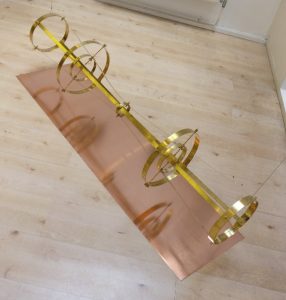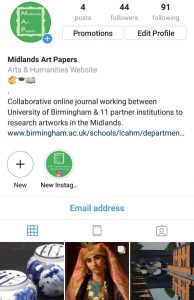My time working on the Midlands Art Papers (MAP) has been a great exercise in independent research and improving my digital communication skills. When I first applied for the research placement, I did so to receive my first publication and to work on an academic journal proofreading and copyediting. However, I have gained much more than that and consider this whole placement foundational experience moving into my PhD and career thereafter.

So, what is MAP? MAP is a collaborative online journal that aims to bring the art and design collections of eleven partner institutions across the region to the public. The editor is Dr. Kate Nichols, from the Department of Art History, Curating and Visual Studies at the University of Birmingham. Being an online journal, MAP is active on social media, with a Twitter and blog, and now an Instagram account as well. These are used to promote both the online journal and the eleven partner institutions, making their collections more accessible.
There were three roles to undertake during my research placement with MAP. These were:
- collaborate with a partner collection to identify and undertake research into an object for the second issue of MAP.
- act as an editorial assistant for second issue of MAP, responsible for proof-reading submissions and preparing manuscripts in house style.
- create content for the MAP blog and promote MAP on social media.
Initially, I was most keen on my first task and immediately began researching Unskinned corsetry enters stage right (2018), a sculptural piece that was on display in the Royal Birmingham Society of Artists during the summer. What became apparent, however, was that my article would work better as an exhibition review. This was influenced by the fact that I got to interview the artist, Yazmin Boyle, about the specific piece and the exhibition. Without this interview, the article would have been lacking, as I explore the critical theory, feminism, and intellectual consideration behind Boyle’s work. As a strong feminist art historian, this was an incredibly rewarding interaction with an artist. It showed me the importance of an artist’s voice within the discipline of art history and the responsibility of the art historian to include it. As I move into my PhD, I hope to take this knowledge and apply in in that realm.

The most rewarding aspect of my placement took me by surprise; web content creation. This included contributing to the blog, using Twitter, and looking after the Instagram account. I will be maintaining the Instagram account over the next few months, which I am excited about. I have some things planned, so watch this space!
Through the blog, I was able to immerse myself more fully into the arts and culture sector of Birmingham. The knowledge that I would write a blog about an exhibition aided my ability to combine visual and written information into a coherent and critical response, but more importantly, increased my enjoyment of exhibitions.

This placement has given me invaluable experience and improved my ability to research independently as well as my digital communication skills. More specifically, the experience helped me evolve an academic language that was more approachable to a non-academic audience. Overall, the CAL PGT Research Placement has given me confidence in my decision to pursue doctoral research, showed me unexpected career avenues, and innumerable other benefits. Many thanks to Edward Mushett Cole and the whole CAL PGT Research Placement team!
Cai Lyons, MA History of Art
